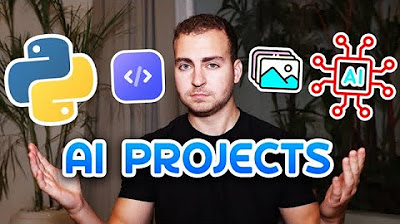Google's 8 Hour AI Essentials Course In 15 Minutes
Summary
TLDRThis video offers a condensed version of Google's AI Essentials course, covering five key modules. It starts with a basic introduction to AI and machine learning, explaining concepts like generative AI and large language models. The video emphasizes maximizing productivity with AI tools, using the human-in-the-loop approach, and diving into the art of prompt engineering for better AI interaction. It highlights the importance of responsible AI use, addressing biases and harm, and provides an introduction to AI safety. The content also includes practical tips, real-world examples, and a self-assessment to enhance learning retention.
Takeaways
- 😀 AI is defined as computer programs that perform cognitive tasks typically associated with human intelligence, such as recommendations or navigation.
- 😀 Machine learning (ML) allows AI to analyze data and make predictions, such as determining if an apple is ripe based on given examples.
- 😀 Generative AI, a subset of AI, can create new content like text or images and is the focus of this course, with models like Google's Gemini as prime examples.
- 😀 Interacting with AI requires effective prompting, which involves providing clear, specific instructions to generate accurate outputs.
- 😀 The 'human-in-the-loop' approach emphasizes that humans should be the final decision-makers when using AI to ensure quality and accountability.
- 😀 AI tools can experience issues like knowledge cutoffs (being unaware of current events) and hallucinations (producing incorrect or fabricated information).
- 😀 To optimize prompt engineering, it's important to iterate on prompts, starting simple and adding detail based on the AI’s responses.
- 😀 Using examples in prompts (e.g., 'zero-shot', 'one-shot', or 'few-shot') can significantly improve the AI’s accuracy and relevance in its output.
- 😀 Chain of Thought prompting is an advanced technique where the AI breaks down complex tasks into smaller, manageable subtasks, which aids in more accurate results.
- 😀 Responsible AI involves understanding potential harms, such as biased outputs or performance discrepancies across different user groups, and mitigating these risks through diverse development teams and constant feedback.
- 😀 AI models should be continually updated and monitored for improvements, especially as AI tools advance and more sophisticated use cases emerge.
Q & A
What are the five modules covered in Google's AI Essentials course?
-The five modules in Google's AI Essentials course are: 1) Introduction to AI, 2) Maximizing productivity with AI tools, 3) Prompt Engineering, 4) How to use AI responsibly, and 5) Staying ahead of the curve in AI developments.
How is Artificial Intelligence (AI) defined in the course?
-AI refers to computer programs that can perform cognitive tasks typically associated with human intelligence, such as Google Maps helping users navigate to a restaurant or YouTube recommending videos based on user preferences.
What is the difference between Machine Learning and Generative AI?
-Machine Learning refers to computer programs that can analyze data and make predictions, like determining whether an apple is ripe. Generative AI, a subset of AI, generates new content, such as text, images, or media, and is the focus of the course.
What is the human-in-the-loop approach advocated in the course?
-The human-in-the-loop approach involves humans being part of the process when interacting with AI, ensuring that the final decisions, like selecting a slogan or diagnosing a medical issue, are made by humans rather than blindly relying on AI.
What are two common issues to watch out for when using AI?
-Two common issues with AI are its 'knowledge cutoff,' meaning AI lacks knowledge about events that occurred after its training date, and 'hallucinations,' where AI can generate incorrect or fabricated information.
Why is 'prompt engineering' important when using AI?
-'Prompt engineering' is essential because how you phrase your prompts can significantly affect the quality and accuracy of the AI's output. Clear, specific prompts with context help achieve better results.
What does 'iterative prompting' mean?
-Iterative prompting refers to the process of refining and improving your prompt through multiple iterations, starting with a simple prompt, evaluating the results, and adding more details until the desired output is achieved.
How can the use of examples improve prompting?
-Using examples (also known as 'shots') helps the AI understand the desired outcome. Zero-shot prompting provides no examples, one-shot gives one example, and few-shot provides multiple examples, leading to more specific and nuanced answers.
What is 'Chain of Thought' prompting?
-Chain of Thought prompting involves asking the AI to break down a task into smaller, logical steps. This approach is useful for complex problems, allowing the AI to generate structured, step-by-step solutions.
What are some ethical concerns regarding AI as mentioned in the course?
-Ethical concerns about AI include quality of service harm, where AI tools may not perform well for certain groups, and representation harm, where AI may reinforce societal biases, like associating nurses with women and doctors with men.
Outlines

このセクションは有料ユーザー限定です。 アクセスするには、アップグレードをお願いします。
今すぐアップグレードMindmap

このセクションは有料ユーザー限定です。 アクセスするには、アップグレードをお願いします。
今すぐアップグレードKeywords

このセクションは有料ユーザー限定です。 アクセスするには、アップグレードをお願いします。
今すぐアップグレードHighlights

このセクションは有料ユーザー限定です。 アクセスするには、アップグレードをお願いします。
今すぐアップグレードTranscripts

このセクションは有料ユーザー限定です。 アクセスするには、アップグレードをお願いします。
今すぐアップグレード5.0 / 5 (0 votes)






